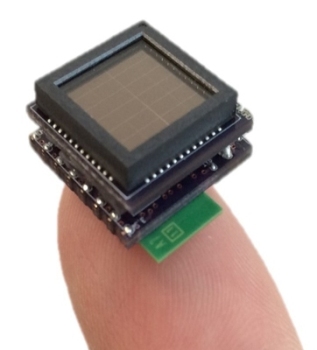Aug 21 2015
Cypress Semiconductor Corp. today announced a new family of Energy Harvesting Power Management Integrated Circuits (PMICs) that enable tiny, solar-powered wireless sensors for Internet of Things (IoT) applications. The new devices are the world's lowest-power, single-chip Energy Harvesting PMICs, and can be used with solar cells as small as 1 cm2.
The new PMIC devices are fully integrated, making them ideal for batteryless Wireless Sensor Nodes (WSNs) that monitor physical and environmental conditions for smart homes, commercial buildings, factories, infrastructure and agriculture. Cypress offers a complete, battery-free Energy Harvesting solution that pairs the S6AE101A PMIC, the first device in the new family, with the EZ-BLE™ PRoC™ module for Bluetooth® Low Energy connectivity, along with supporting software, in a $49 kit.
 Pictured is a demonstration of a tiny 1 cm by 1 cm solar-powered Wireless Sensor Node using the S6AE101A Energy Harvesting Power Management IC (PMIC) solution from Cypress Semiconductor Corp.
Pictured is a demonstration of a tiny 1 cm by 1 cm solar-powered Wireless Sensor Node using the S6AE101A Energy Harvesting Power Management IC (PMIC) solution from Cypress Semiconductor Corp.
The WSN IoT device market is expected to grow to more than 5 billion units by 2020, putting a premium on battery-free implementations to reduce cost and maintenance problems. The placement of a WSN may limit its size and the amount of light available, thereby limiting the size and power output of the solar module and the startup power available for the Energy Harvesting PMIC. The new Cypress Energy Harvesting PMIC devices address these challenges with startup power of 1.2uW—4x lower than the nearest competitor—and consumption current as low as 250nA, maximizing the power available for the sensing, processing and communications functions of a target application. The fully-certified, small-form-factor EZ-BLE PRoC module, which is based on Cypress's PRoC BLE Programmable Radio-on-Chip solution, works with the PMIC devices to contribute to the low power and ease-of-use of an energy harvesting system solution.
"The most compelling new Wireless Sensor Nodes that will drive IoT growth are self-powered, can be deployed anywhere for more than 10 years, and require minimal deployment and maintenance costs," said Kiyoe Nagaya, vice president of the Analog Business Unit at Cypress. "Using our new Energy Harvesting PMIC and EZ-BLE PRoC Bluetooth Smart module, Cypress offers a complete solution that enables developers to create solar-powered WSNs for batteryless IoT devices."
About Cypress's Award-winning Energy Harvesting PMICs
Cypress PMICs enable efficient harvesting from sunlight, vibrations and thermal variations, and offer dual inputs from two sources simultaneously, making them a reliable, flexible option to fully power or extend the battery life in IoT applications.
The Cypress energy harvesting PMICs have received several industry awards, including:
- The 2015 Annual Creativity in Electronics (ACE) Award for Energy Technology , presented by EDN and EE Times.
- The Product of the Year Award for the MB39C811 PMIC from the Environmental Leader Product & Project Awards in March 2015. The judges recognized several key qualities of the energy harvesting technology that is now a part of Cypress's portfolio following the completion of its merger with Spansion.
- The Emerging Technology Award, Second Place in M2M, IoT, Sensors, RFID & NFC for the ultra low power buck PMIC for solar and vibrations energy harvesting, MB39C811 from CTIA in 2014.
- The Green IT Award program for energy harvesting solutions from the Ministry of Economy, Trade and Industry of Japan in 2013.
Availability and Design Tools
The Cypress S6AE101A Energy Harvesting PMIC is sampling now, with production expected in the fourth quarter of 2015. Cypress offers the $49 Solar-Powered IoT Device Kit that contains a baseboard with a solar module and a Bluetooth® Low Energy-USB bridge. Cypress PMICs are supported by the comprehensive Easy DesignSim™, a free, web-based simulation tool for Cypress's PMIC solutions used to validate Energy Harvesting System (EHS) designs, including the bill-of-materials (BOM), schematic and the power consumed (ìW) by the sensing, processing and communications functions of a target application.
Source: http://www.cypress.com